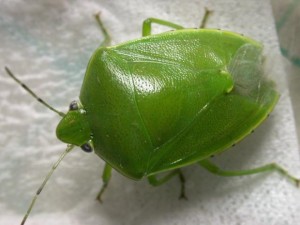Does it look like a tiny shotgun has blasted the leaves of your eggplant? (See Figure 1 for an example.) Chances are you have a flea beetle infestation. First of all, don’t worry, “flea” beetles only bite plants! These are not like the fleas on your dog or cat. That’s a whole different order of insects. These are very small (1/10 inch) leaf-feeding beetles that are called “flea” beetles due to their large hind legs which enable them to jump much like fleas (Figure 2).

Figure 1. Eggplant with flea beetle damage. Photo, Ali Eminov [CC BY-NC-ND 2.0]
There are several species found in Missouri but the only species I see regularly is all black. Depending on the species, they may feed on cruciferous vegetables, spinach, turnips, radishes, tomatoes, potatoes, peppers, beans or eggplant. The good news is that the adults die off in July. The bad news is, they can have two generations per year, meaning they can come back for your fall crops. Generally speaking I ignore flea beetles and their damage except when it comes to young seedlings. (Mature plants can usually sustain a bit of flea beetle damage to leaves and still provide fruit.)
For years, flea beetles have severely damaged my eggplant transplants. If I’m lucky, a couple plants survive, and, by late summer, I finally have plants that are large enough to produce. I have tried row covers to no avail. The problem here is that the adults overwinter in your soil and leaf litter. Despite clearing the plant debris from my garden in the fall there are still plenty of hungry adult flea beetles just waiting in the soil for some tender eggplant leaves.
Last year I tried an experiment. Since I only grow four eggplant every year, I went out and purchased some hard plastic domed frost guards. Eggplant are notoriously cold sensitive, so why not? In addition, I thought they might act as a physical barrier to hungry flea beetles. I figured if I found any beetles under the dome, I would shoo them off and quickly replace it since flea beetles jump when startled. In practice, I never needed to do this as the domes worked quite well. After a week I checked and the transplants were hole-free. To test my experiment, I uncovered one of my eggplants. Three days later, when I went out to compare it to the still-covered plants, I found that the unprotected plant was COVERED with flea beetles and feeding holes. The domes worked!
Then, in an effort to save my sacrificial eggplant, I tried spraying it with organic neem oil. WOW! Another real find! It took several sprays, but apparently the flea beetles think it tastes as bad as it smells! They either died or left. My eggplant grew up, became highly productive, and I ended up with a freezer full of tasty ratatouille which my sweet husband enjoys.*
While I think I’ve cracked the code on safe ways to control flea beetles, there are some good suggestions on the websites listed below for other earth-friendly ways to lessen flea beetle damage:
* I have the BEST recipe for ratatouille. Email me at kathy@comogardens.org if you’d like it.


























 Hi! My name is Kathy E. Doisy, and I am a new board member for the Community Garden Coalition. I have always admired this organization because it helps so many people, and it’s completely volunteer. I’ve been an avid gardener since 1976, and I’m a retired entomologist so I have a lot of knowledge about gardening and garden pests. As the season goes forward, I’ll be posting timely information about common garden pests in a column we’re calling “The Boone County Buzz.” In the meantime I thought I might suggest a way that you can prepare for next year’s crops and help the environment at the same time.
Hi! My name is Kathy E. Doisy, and I am a new board member for the Community Garden Coalition. I have always admired this organization because it helps so many people, and it’s completely volunteer. I’ve been an avid gardener since 1976, and I’m a retired entomologist so I have a lot of knowledge about gardening and garden pests. As the season goes forward, I’ll be posting timely information about common garden pests in a column we’re calling “The Boone County Buzz.” In the meantime I thought I might suggest a way that you can prepare for next year’s crops and help the environment at the same time.